The A2 Ice Cream Market is estimated to be valued at USD 3449.6 million in 2025 and is projected to reach USD 6598.1 million by 2035, registering a compound annual growth rate (CAGR) of 6.6% over the forecast period.
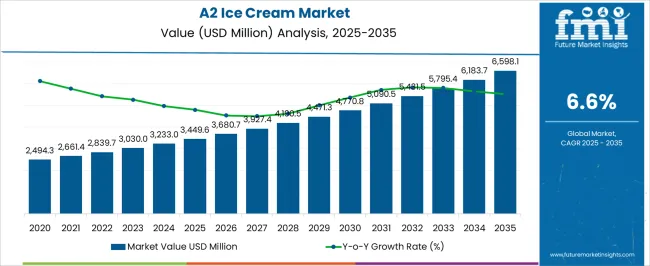
| Metric | Value |
|---|---|
| A2 Ice Cream Market Estimated Value in (2025 E) | USD 3449.6 million |
| A2 Ice Cream Market Forecast Value in (2035 F) | USD 6598.1 million |
| Forecast CAGR (2025 to 2035) | 6.6% |
The A2 ice cream market is experiencing notable growth, driven by rising consumer preference for digestive-friendly dairy products and increasing awareness of the benefits of A2 protein. Enhanced consumer focus on health, coupled with indulgence in premium desserts, has fueled the adoption of A2-based formulations.
The market benefits from the perception of A2 milk as a healthier alternative to conventional dairy, which has positioned A2 ice cream as a functional yet indulgent offering. Premiumization trends and the expansion of modern retail channels have further contributed to product visibility and accessibility.
In addition, growing urbanization and demand for clean-label, natural, and allergen-friendly products have provided sustained momentum. With ongoing product innovations in flavors, packaging, and formats, and the increasing role of supermarkets and online platforms in distribution, the market outlook remains favorable with strong growth potential across both developed and emerging economies.
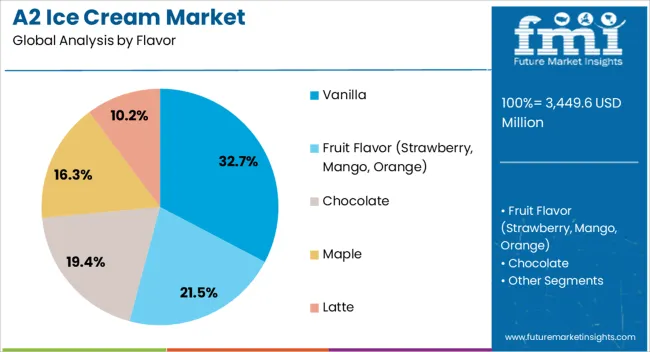
The vanilla segment holds approximately 32.70% share in the flavor category of the A2 ice cream market. This dominance is attributed to vanilla’s position as a universally accepted and versatile flavor, widely favored by consumers across age groups.
Vanilla also serves as a base for numerous dessert pairings and toppings, making it a staple choice in both retail and foodservice channels. The flavor’s neutral and adaptable profile allows it to appeal to consumers seeking both traditional indulgence and healthier alternatives.
Market growth has been further supported by its frequent use in premium and artisanal formulations, reinforcing its position as a leading flavor option. With consistent demand across global markets, the vanilla segment is expected to sustain its leadership during the forecast period.
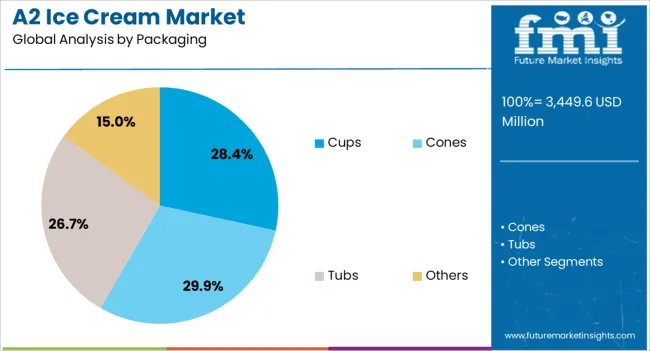
The cups segment accounts for approximately 28.40% of the packaging category in the A2 ice cream market. This segment’s growth is supported by consumer preference for convenient, portion-controlled servings that enhance portability and reduce waste.
The use of cups aligns with hygiene and safety standards, making them suitable for both individual consumption and on-the-go lifestyles. In addition, cups offer branding opportunities through customizable designs, strengthening visibility on retail shelves.
Their adaptability to multiple portion sizes has ensured popularity across both mass-market and premium product ranges. With growing demand for convenient and hygienic dessert packaging, the cups segment is anticipated to maintain a significant share.
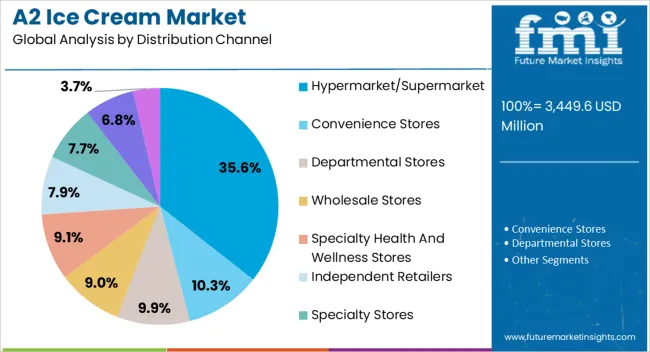
The hypermarket/supermarket segment leads the distribution channel category with approximately 35.60% share. This segment’s strength is derived from the ability of large retail formats to provide broad product visibility, variety, and competitive pricing.
Consumers prefer purchasing frozen products like A2 ice cream from these channels due to reliable cold chain infrastructure and attractive in-store promotions. The segment is further reinforced by increasing urbanization and rising penetration of organized retail in developing economies.
With consumers valuing product assortment and quality assurance, hypermarkets and supermarkets are expected to remain the dominant channel for A2 ice cream distribution.
The A2 ice cream market is projected to reach USD 3449.6.0 million in 2025 and USD 6598.1.0 million by 2035. Growing consumer interest in healthy and more easily digestible options, along with the growing availability and variety of A2 ice cream products, is fueling the market’s expansion.
The global A2 ice cream market experienced steady growth from 2020 to 2025, as A2 ice cream manufacturers grew from strength to strength, attracting a wider variety of consumers. A higher number of health-conscious, lactose intolerant, but still desirable of ice cream, consumers veered towards the product in the historical period.
In recent years, there has been a global movement toward eating healthy foods and raising awareness of food sensitivities. A2 milk and, by extension, A2 ice cream have been promoted as alternatives that are set to be easier for people to digest if they have trouble with A1 milk.
The growing interest in gut health has offered opportunities to A2 ice cream stakeholders. Milk and milk products are being widely advertised as beneficial to gut health, widening the scope of the industry.
Food producers are always trying to come up with new ways to innovate and set themselves apart from the competition. A2 ice cream is a new product on the ice cream market because of its distinctive milk composition.
The table below shows the estimated growth rates of the top four countries. Germany, the United States, and Australia are set to record higher CAGRs of 8.2%, 7.8%, and 7.5%, respectively, through 2035.
| Countries | CAGR |
|---|---|
| United States | 7.8% |
| Japan | 7.0% |
| Australia | 7.5% |
| Germany | 8.2% |
The United States A2 ice cream market is expected to surge at a CAGR of 7.8% by 2035. A2 ice cream is in high demand due to consumers' growing emphasis on health & wellbeing and the supposed health advantages of A2 milk.
The increased lactose-intolerant population has contributed to this trend by encouraging consumers to look for alternative dairy products like A2 ice cream and milk. Developed retail infrastructure, including supermarkets, convenience stores, and specialty food retailers, provides extensive distribution channels for A2 ice cream products and fuels the market.
Germany is projected to rise at a CAGR of 8.2% by 2035. Increasing consumer focus on health and growing awareness of the potential health benefits of consuming dairy products free from A1 protein is gaining traction in Germany. Germany’s market is known for its high-quality and innovative food products, which has created a favorable environment for introducing and succeeding ice cream made with A2 milk.
High-end food items are being embraced by the upper tier of income earners in China. A2 ice cream is just another product that is thriving due to Chinese tongues wagging for premium products with health benefits and manufacturers are not lagging behind.
E-commerce plays a prominent part in the industry’s popularity in China. The online boom has been a boon for premium food products in China and A2 ice cream is riding the wave of popularity.
Due to its possible digestive advantages, A2 milk is becoming increasingly popular, and this interest is set to extend to A2 ice cream. Positioned as a potentially less allergic and easier-to-digest option, A2 ice cream is appealing to health-conscious consumers in Japan. The market is benefitting from consumers wanting distinctive tastes in A2 ice creams, with manufacturers appealing to consumers with upward financial mobility.
Manufacturers in Japan are cognizant of the eco-friendly leaning of Japanese consumers. Thus, sustainable practices are being employed in the manufacturing of the product in Japan.
Non-dairy substitutes are gaining momentum among health-conscious consumers in Australia. Due to the natural and non-dairy qualities of A2 milk used in the making of A2 ice cream, consumers in Australia are directed toward A2 ice cream over traditional ice creams.
Marketing tactics like the advertising of A2 milk’s easy digestion are proving to be a slam dunk for Australian stakeholders. The health benefits of the product are front and center in the marketing tactics.
Australian consumers are taking more interest in the sourcing of ingredients in their food products. Environmentally concerned consumers are drawn to brands that emphasize sustainable production practices or locally sourced A2 milk.
The below section shows the chocolate segment dominated by flavor. It is predicted to hold a market share of 38.0% in 2025. Based on packaging, the cup segment is anticipated to generate a moderate share through 2025. It is set to hold a share of 25.6% in 2025.
| Segment | Market Share (2025) |
|---|---|
| Chocolate (Flavor) | 38.0% |
| Cups (Packaging) | 25.6% |
| Hypermarket/Supermarket (Distribution Channel) | 28.5% |
Based on flavor, chocolate is estimated to dominate the global market by holding a share of 38.0% in 2025. Chocolate emerges on top as a carryover from traditional ice cream. Chocolate invokes in consumers’ minds swirling tastes and a delectable sweet flavor, variously being consumed by children to being used as an aphrodisiac by adults.
Based on packaging, cups are expected to hold a market share of 25.6% in 2025. Cup has endured as an option because it is easy to hold and serve in, practical to use, and can be loaded with single or double scoops as the wish of the customers entails.
Cup packaging endures as it is suitable for both shop consumption and can also be taken on the go, unlike an alternative like cone. Cups being packaged with airtight leads also keep the ice cream inside fresh if the eating will happen later in time.
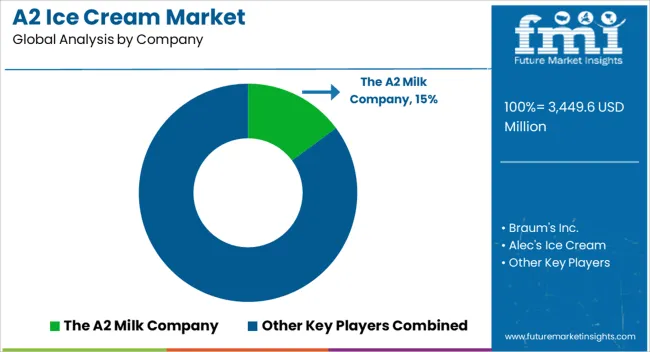
The competitive environment in the A2 ice cream market is diversified and active. Leading firms specialized are focused on research & development, sustainable sourcing, and novel formulations.
Key manufacturers place a premium on environmentally friendly operations, product certifications, and meeting the growing demand for natural & sustainable products. A client-first approach is often seen, with manufacturers bringing out seasonal or trendy flavors.
Product Launches and Key Developments
| Attribute | Details |
|---|---|
| Estimated Value (2025) | USD 3449.6 million |
| Projected Value (2035) | USD 6598.1 million |
| Anticipated Growth Rate (2025 to 2035) | 6.6% |
| Forecast Period | 2025 to 2035 |
| Historical Data Available for | 2020 to 2025 |
| Market Analysis | USD million for Value, MT for Volume |
| Key Regions Covered | North America; Latin America; Europe; East Asia; South Asia; and the Middle East and Africa |
| Key Countries Covered | United States, Canada, Brazil, Mexico, Germany, United Kingdom, France, Italy, Spain, Nordic, Russia, Poland, China, India, Thailand, Indonesia, Australia and New Zealand, Japan, GCC countries, North Africa, South Africa, and others. |
| Key Segments Covered | Flavor, Packaging, Distribution Channel, and Region |
| Key Companies Profiled | The A2 Milk Company; Braum's Inc.; Alec's Ice Cream; GoDesi Milk; Re:THINK; Miller's Bio Farm; UNITED FARMERS CREAMERY; APPLEBY FARMS ICE CREAM; MOO-ville Creamery; THAYUMANAVAR A2 DAIRY FARMS PVT LTD; Amos Miller Organic Farm; Highland Farms; PEI ORGANIC FOODS LLP |
| Report Coverage | Market Forecast, Company Share Analysis, Competition Intelligence, Drivers Restraints Opportunity Trends Analysis, Market Dynamics and Challenges, and Strategic Growth Initiatives |
The global A2 ice cream market is estimated to be valued at USD 3,449.6 million in 2025.
The market size for the A2 ice cream market is projected to reach USD 6,598.1 million by 2035.
The A2 ice cream market is expected to grow at a 6.6% CAGR between 2025 and 2035.
The key product types in A2 ice cream market are vanilla, fruit flavor (strawberry, mango, orange), chocolate, maple and latte.
In terms of packaging, cups segment to command 28.4% share in the A2 ice cream market in 2025.






Full Research Suite comprises of:
Market outlook & trends analysis
Interviews & case studies
Strategic recommendations
Vendor profiles & capabilities analysis
5-year forecasts
8 regions and 60+ country-level data splits
Market segment data splits
12 months of continuous data updates
DELIVERED AS:
PDF EXCEL ONLINE
A2 Lactose-Free Milk Market Analysis – Size, Share, and Forecast Outlook 2025 to 2035
A2 Milk Market Analysis - Size, Share, and Forecast Outlook 2025 to 2035
A2 Infant Formula Market Analysis By Form Type, By Age Group, By Distribution Channel and By Region - Forecast from 2025 to 2035
A2 Yogurt Market Trends – Growth, Demand & Innovations
A2P Messaging Market - Trends & Forecast through 2034
A2P & P2A Messaging – AI-Driven Communication & Security
Enterprise A2P SMS Market Size and Share Forecast Outlook 2025 to 2035
ICE Start And Stop System Market Size and Share Forecast Outlook 2025 to 2035
Ice Boxes Market Size and Share Forecast Outlook 2025 to 2035
Analysis and Growth Projections for Iced Tea Business
Ice Detection System Market Trends, Growth & Forecast 2025 to 2035
Ice Cube Tray Market Trends & Growth Forecast 2024-2034
Ice Maker Machines Market
Ice Transport Buckets Market
Ice Cream Coating Market Size and Share Forecast Outlook 2025 to 2035
Ice-cream Premix and Stabilizers Market Size and Share Forecast Outlook 2025 to 2035
Ice Cream Equipment Market Size and Share Forecast Outlook 2025 to 2035
Analysis and Growth Projections for Ice Cream and Frozen Dessert Market from 2025 to 2035
Ice Cream Packaging Market - Outlook 2025 to 2035
Ice Cream Processing Equipment Market Growth - Trends, Demand & Innovations 2025 to 2035

Thank you!
You will receive an email from our Business Development Manager. Please be sure to check your SPAM/JUNK folder too.
Chat With
MaRIA